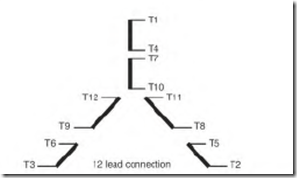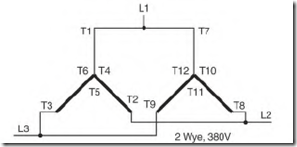The 12-lead connection (numbered 1 through 12) will have six pairs of leads that light to each other. Figure 5.56 shows the connection. The difference between this connection and the nine-lead connection is that the end of each phase (T10, T11, and T12) is accessible in the motor’s connection box.
The 12-lead motor can be connected to four different voltages: wye-delta, one-delta start, two-wye run, and variations of part-winding start methods.
Figure 5.57 is the two-delta connection, which has the lowest voltage rating. Regardless of what the two-delta connection voltage rating is, the voltage rating of the two-wye connection is 1.73 (square root of 3) times that voltage (Fig. 5.58). In this case, if the two-delta connection is rated 220 volts 220 x 1.73 = 380. The two-wye connection is rated 380 volts.
FIGURE 5.56 The 12-lead numbering sequence used in the United States.
FIGURE 5.57 The lowest voltage connection for the 12-lead motor is two delta.
FIGURE 5.58 The voltage rating for the two-wye connection is 1.73 times the two-delta connection.
FIGURE 5.59 The voltage rating for the one-delta connection is twice that of the two-delta connection.
If a two-delta (parallel) connection is rated 220 volts, a one-delta (seriesconnected) is rated 440 volts (Fig. 5.59).
If a two-wye (parallel) connection is rated 380 volts, a one-wye (seriesconnected) is rated 760 volts (Fig. 5.60).
The 12-lead connection can be used as a part-winding start on two voltages. It can be connected two wye to start and two delta for run (operating on the two-delta voltage). It can also be connected one-wye start and one-delta run (operating on the one-delta voltage).
Another start method (made possible by the 12-lead connection) is onedelta start and two-wye run. This connection will produce 40 percent more starting torque than the wye-start, delta-run connection. (The increased starting torque will require higher inrush amperes.)
FIGURE 5.60 The voltage rating for the one-wye connection is twice that of the two-wye connection.
The operating voltage must be that of the two-wye connection and may require rewinding the motor for this voltage.
Dual-Voltage Multispeed Motors
The dual-voltage connection is rarely encountered in two-speed motors. As shown in the following schematics, dual-voltage two-speed motors require 18 leads. The schematics in Figs. 5.61, 5.62, and 5.63 (a and b) are constanttorque, constant-horsepower, and variable-torque dual-voltage connections, respectively.
The two-speed dual-voltage-connected winding can’t be used with another winding. There are many closed-loop parallel circuits with the twospeed dual-voltage motor connected low voltage (5.63b). All the closed-loop circuits have to be opened when this winding is idle.
European Connections
The International Electrotechnical Commission (IEC) labeling system is used in Europe and Great Britain. Figures 5.64 and 5.65 show this labeling system. Much of the equipment brought into the United States from Europe and Great Britain has motors with this lead numbering system.
Figures 5.66 and 5.67 show the former European connections for the wye-delta and 12-lead motors. Figures 5.68 and 5.69 give the former Great Britain connections for the wye-delta and 12-lead motors.
Most of these motors are designed to operate on 50 Hz. The horsepower ratings are usually given in kilowatts. (Conversion to 60 Hz was explained earlier in this chapter, under “Operation of the Three-Phase Motor.




